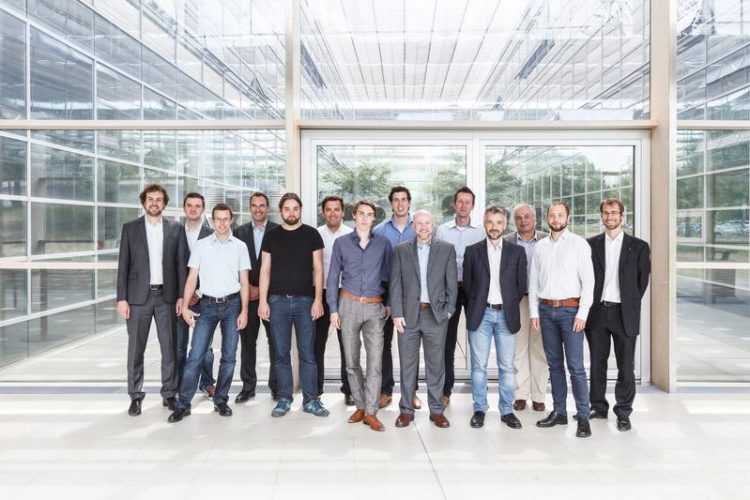Kick-off of European ROS-Industrial consortium at Fraunhofer IPA

Participants at the kick-off with head of the European ROS-Industrial consortium Ulrich Reiser, Fraunhofer IPA (right). source: Fraunhofer IPA
Under the leadership of Fraunhofer IPA, the kick-off of the European ROS-Industrial consortium as well as the second international ROS-Industrial conference took place in Stuttgart at the end of June 2014. Experts from industry and research presented the key developments, applications, components and trends around the subject of ROS-Industrial.
The ROS-Industrial initiative was set up two years ago with the goal of adapting ROS for industrial applications. Fraunhofer IPA, which is heading this initiative in Europe, hosted the kick-off of the ROS-Industrial consortium as well as the second international ROS-Industrial conference at the end of June 2014.
Automation technology has to date been strongly characterized by proprietary interfaces and, therefore, by strong ties to robot and control manufacturers. The ROS-Industrial vendor-neutral open-source software platform makes it possible for robot-based automation solutions to be developed faster and more efficiently than before. Reusable modules offer significant potential savings, especially for system integrators.
Transfer from research to industry: advantages of ROS-Industrial
ROS has long been an ideal internal development tool within the research community. It offers a host of advantages: it is simple to use and offers users with no training in software development, robotics or mechatronics an easier entry into complex robot applications. “ROS is flexible and scalable: whether in the hobby segment or for large industrial applications – ROS is versatile in use, also with several robots,” explains Dirk Thomas from the Open Source Robotics Foundation.
“However, end users and customers were increasingly asking us questions about certain problems that we were unable to solve using the existing components and applications. So we developed ROS-Industrial as an open, flexible framework for industrial applications,” says Clay Flannigan from the Texas-based Southwest Research Institute (SWRI). ROS is being further developed and improved to meet additional non-functional requirements from industry, such as robustness, reliability and safety.
Thanks to standardized interfaces and high-grade software components, ROS-Industrial reduces the integration effort for robot-based solutions. Model-based IT tools are available for the selection, configuration and integration of ROS-Industrial components. “The purpose of the ROS-Industrial consortium is to channel the requirements of industry into the ROS developer community to allow the transfer of high-performance software components from research to industry.
In collaboration with the developer community, the aim is to implement a technical roadmap for bringing these software components into line with industrial quality and safety standards,” says Ulrich Reiser, group leader at Fraunhofer IPA and head of the European ROS-Industrial consortium. It is also planned to use ROS to develop concrete implementations for previously unsolved automation problems of the consortium members. “The ROS-Industrial consortium also sees its role as a central point of contact for needs-oriented support as well as a source of appropriate training for using ROS-Industrial,” says Reiser.
Contact:
Dr.-Ing. Ulrich Reiser, phone +49 711-970-1330, ulrich.reiser@ipa.fraunhofer.de
Editor:
Dipl.-Journ. Laura Pizzolante, M.A., phone +49 711 970-1108, laura.pizzolante@ipa.fraunhofer.de
Media Contact
All latest news from the category: Machine Engineering
Machine engineering is one of Germany’s key industries. The importance of this segment has led to the creation of new university degree programs in fields such as production and logistics, process engineering, vehicle/automotive engineering, production engineering and aerospace engineering among others.
innovations-report offers informative reports and articles covering technologies such as automation, motion, power train, energy, conveyor, plastics, lightweight construction, logistics/warehousing, measurement systems, machine tools and control engineering.
Newest articles

Parallel Paths: Understanding Malaria Resistance in Chimpanzees and Humans
The closest relatives of humans adapt genetically to habitats and infections Survival of the Fittest: Genetic Adaptations Uncovered in Chimpanzees Görlitz, 10.01.2025. Chimpanzees have genetic adaptations that help them survive…

You are What You Eat—Stanford Study Links Fiber to Anti-Cancer Gene Modulation
The Fiber Gap: A Growing Concern in American Diets Fiber is well known to be an important part of a healthy diet, yet less than 10% of Americans eat the minimum recommended…

Trust Your Gut—RNA-Protein Discovery for Better Immunity
HIRI researchers uncover control mechanisms of polysaccharide utilization in Bacteroides thetaiotaomicron. Researchers at the Helmholtz Institute for RNA-based Infection Research (HIRI) and the Julius-Maximilians-Universität (JMU) in Würzburg have identified a…



